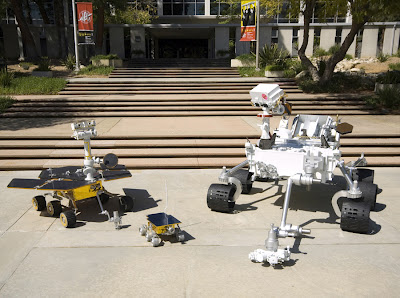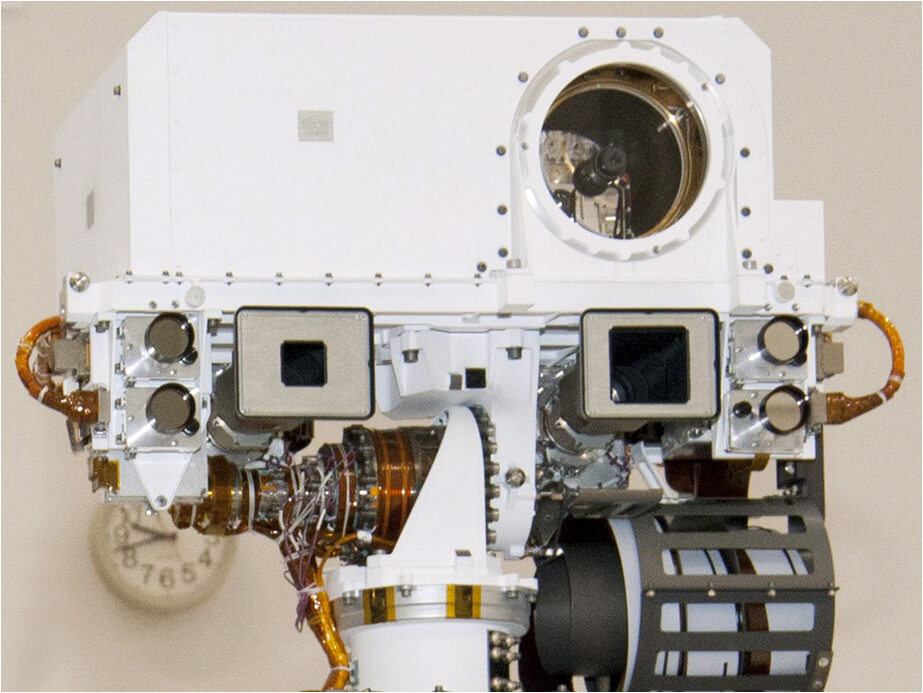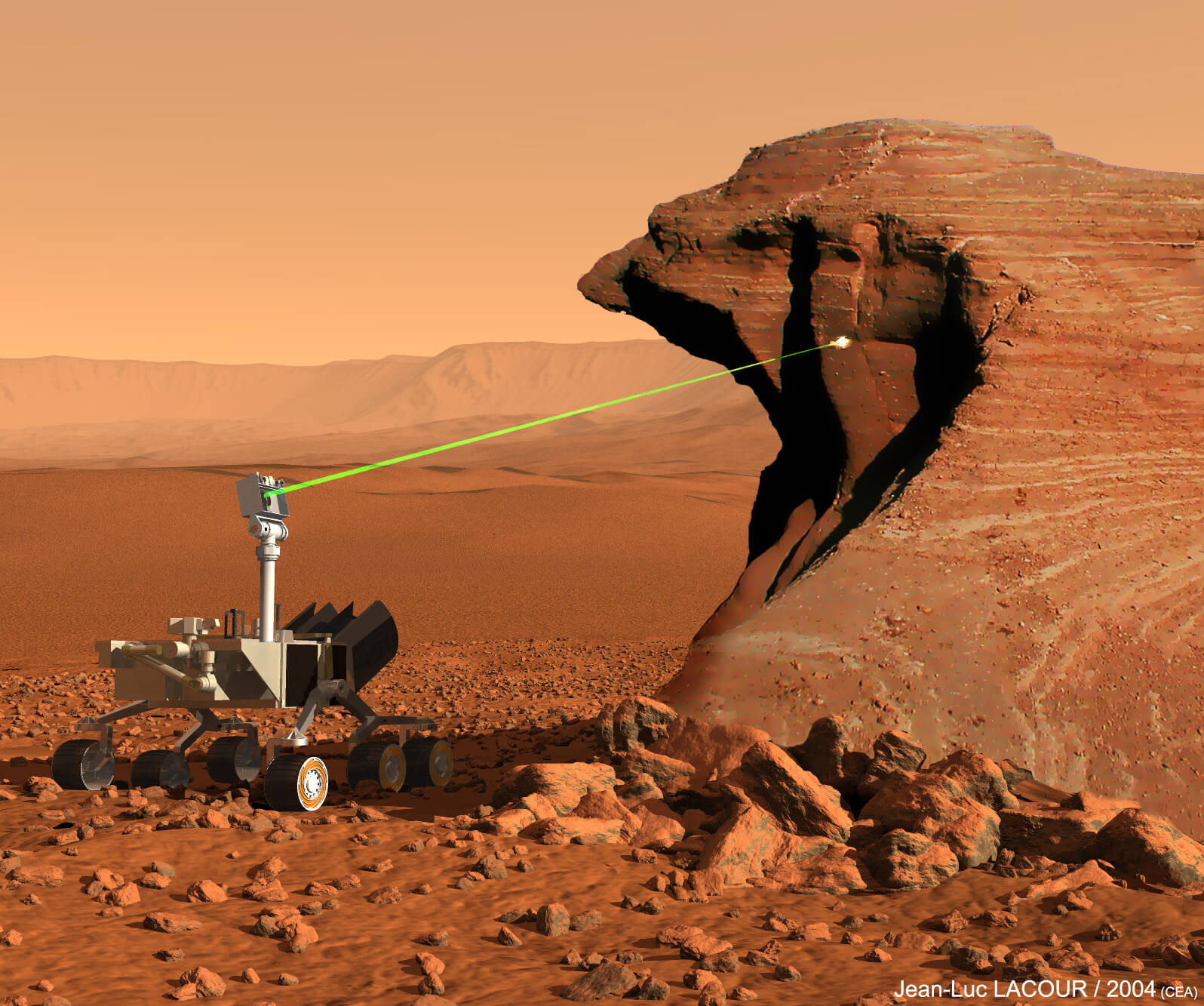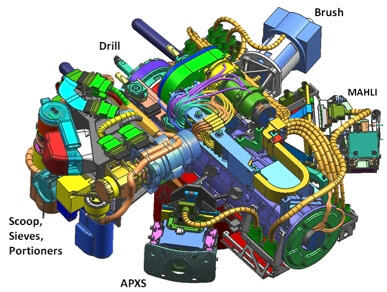The Curiosity rover, which should be launched this morning (Monday) at 08:30 in Gale Crater on Mars, weighs 900 kilograms. This is a lot compared to the previous rover, Opportunity, which has been traveling on Mars since 2004, and weighs only 170 kilograms.

For your attention, this entry is the fifth in a series of articles about Curiosity, which will land on Mars on Monday morning.
You can find links to the previous entries at the bottom of this entry.
The Curiosity rover weighs 900 kilograms. This is a lot compared to the previous rover, Opportunity, which has been traveling on Mars since 2004, and weighs only 170 kilograms.
But the important difference is not the relative weight between them, but the weight of the dedicated payload for which they created this mission, relative to the total weight of the rover. The designated cargo in scientific missions is the research instruments. Opportunity had 5 scientific sensing instruments with a total weight of 5 kilograms. Relative to its weight, this is almost 3%.
Curiosity has 10 scientific measuring instruments with a total weight of 75 kilograms, which is 8.3% of the rover's weight. This is the leap: technology that enables a more efficient machine with better capability, that will run for longer.
What equipment is installed on Curiosity?
At the front of the rover is an observation post with a head capable of two degrees of freedom (tilting and raising/lowering), which is 2 meters above the ground. At the top of the page are installed 7 cameras for different roles.

Mastcam - two 2 megapixel cameras that will take color pictures and video for the benefit of scanning the area before traveling, and for engineering assistance for operations such as activating the rover's long arm. The lens assemblies of the cameras are not the same - the lens of the right camera has a long focal length and a narrow field of view, and the left one has a short focal length and a wide field of view. Each of the cameras saves the photos on its own flash memory card, so as not to overload the central computer's memory. This is the method in all other Curiosity cameras as well.
These cameras have a set of color filters that allow photographs of the ground and atmosphere for scientific use. One of the filters is designed to allow the cameras to look directly at the sun, thus measuring the amount of dust in the atmosphere.
ChemCam - this is a camera that aims to identify types of substances from a distance, in order to make decisions about which rock should be approached and where to spend time collecting samples. For this purpose, the camera is equipped with a laser, which is able to ionize the outer layer of rocks at a distance of up to 7 meters, and a telescope to observe the flash that will be created at the point of impact and to characterize the type of minerals according to the light they emit.

Of course you can't see the laser beam.
The camera itself is monochromatic with a resolution of 1 megapixel, and can also be used for observation without activating the laser. The laser is activated for short pulses, about 5 billionths of a second, and during this time it transfers over a million watts to its target.
The spectrometer device that analyzes the resulting plasma flash recognizes 6144 different wavelengths, in the infrared to ultraviolet range, and the identification of their combinations enables identification of the types of material covering the rock burned by the laser.
This device is also relatively fast compared to the solid material analysis devices installed on Curiosity, whose duration of operation on a single sample can last for days.
NavCam – two pairs of cameras designed to direct the rover as it travels. The cameras work together for stereoscopic vision.
Two environmental sensors called REMS are also installed on the observation post, which will collect information almost continuously for the duration of the mission. The sensors will measure wind speed and direction, air pressure, humidity, air temperature, soil temperature, and the ultraviolet radiation coming from the sun.
In the lower part of the rover, in the front and in the rear, two pairs of HazCam cameras are installed, whose role is to assist in navigation through close-range observation - near the belly of the rover. Their other role is to help direct Curiosity's arm when it is close to the ground.
RAD - sensor for radiation assessment. It is actually a telescope with a wide field of view, designed to detect cosmic radiation and high-energy particles coming from space and potentially damaging living tissues, and thus will collect information that will be essential for planning a human expedition to Mars in the future. This device is already working and records the radiation that reaches Curiosity during its journey through space on the way to Mars.
DAN - a device for identifying minerals below the surface. This device is located at the bottom of the rover, and uses the method of releasing neutrons to the ground, and monitoring the returning neutrons. According to the momentum of the returning particles it is possible to determine the mass of the affected atoms and thus the type of material hidden under the ground.

Curiosity has an arm at its front, designed for close examination and collection of soil samples. The arm is articulated, two meters long, and has five degrees of freedom. The turret at the end contains instruments for collecting geological samples.
MAHLI - the "magnifying glass" of the arm. This is a color camera with a controllable focal length. When it will be used to examine rocks closely, it will be able to reach a resolution of less than 14 microns (!), a parameter that will allow minerals to be identified according to their crystalline structures. By moving the focal point, it will be able to detect details half a millimeter in size from a distance of one meter.
When you look closely at the ground there may be a problem of shading, so the camera is equipped with two LEDs that will allow photography even in night conditions. Two additional LEDs will be used for ultraviolet frequency lighting, which will enable the testing of fluorescent materials.
APXS - a spectrometer that shoots alpha particles (helium nuclei that are emitted in the natural decay of a radioactive substance) at a nearby target, and the target "responds" by emitting X-rays that the device measures and thus is able to identify the material from which the target is made. This device is capable of detecting very small amounts of material, and will be used to find targets for collecting samples. The APXS device was present in all the previous rovers that landed on Mars, but this time it was upgraded with a cooling device so that it could also operate during the day, and with the ability to use the particle beam itself in order to measure and reach an ideal distance from the target.
PADS – This is Curiosity's drill and solid material collection tool. It is able to drill up to 5 centimeters into a rock, and collect its powder through the drill. Anyone who has worked with a drill in the past knows that just a rotating drill is not enough, so this drill is also a hammer, which hits the rock while creating the hole. Anyone who has worked with a drill knows that sometimes the drill gets stuck in the wall and is difficult to get out. Curiosity's solution is to disconnect the bit (the drill bit) and leave it in the rock. There are two replacement bits on the front of the rover, and the replacement exercise is fairly simple and quick.
DRT - this is basically a brush for cleaning rock surfaces that you want to examine closely or drill into. The brush is made of steel bristles that rotate with the power of an electric motor, thus cleaning a circle about four centimeters in diameter.
CHIMRA - an instrument box in Curiosity's turret, whose role is to collect, filter and submit soil samples to the analysis instruments inside the rover. The CHIMRA has a small scoop with which you can collect sand from the ground. The dust collected in the drilling also joins this box. After collection, the arm and tower begin a series of movements that transport the collected material through a labyrinth that sorts, filters and collects the samples in measured quantities. The surgical instruments are able to work with grains whose diameter does not exceed a certain size, therefore filtering is required. There are two filters - for a grain size of one millimeter, and for a size of 150 microns.
To help the grains move between the cells and the tiny passages in the device, there is a device that shakes the entire collection box so that the grains cannot stay in one place.
Larger grains can be placed on a small observation tray that protrudes from the front of the rover, where they can be examined with APXS and MAHLI. The tray can be cleaned before use with DRT.
After collection and initial treatment of the collected solid material, it can be put into one of two facilities for chemical analysis of the powders.
CheMin - an experiment for the investigation and analysis of solid samples using an X-ray diffraction pattern. The device is able to identify the type of minerals and their amounts in the soil sample presented to it. The diffraction pattern is created when light of a single wavelength is shone through a very thin layer of material. The crystals of the material create a pattern of light and shadow that characterizes the type of crystal, and thus it can be identified. The filtered powder is poured from the arm into the CheMin funnel on the rover's back, and into one of 32 sampling chambers. Each pair of cells is on a macule-shaped arm, which vibrates to organize the grains in an orderly fashion. The arms are on a wheel that can be rotated to bring each of the cells in front of the X-ray source to examine it.
Examining one CheMin cell takes a long time, up to 10 hours, and it may only be performed on Martian nights because the device's electronics require very low temperatures.
SAM - this is the most sophisticated scientific instrument flown to Mars so far, and the largest installed on Curiosity. It is basically a laboratory for chemical analysis of gaseous substances, both from the atmosphere and from the soil samples. The gases from the atmosphere enter through openings with filters on the front of the rover, and the solids, the same powder collected by the arm, are introduced through one of two funnels on Curiosity's back.
Inside SAM there are two ovens capable of heating the soil sample inside to a temperature of 1000 degrees Celsius. From the gases that are emitted from them during heating, it is possible to identify the substances that make them up, with an emphasis on identifying organic substances.
In order to identify the gases, there are three devices that work together: a mass spectrometer, which identifies gases according to the weight of their molecules, as well as a laser spectrometer and a chromatograph.
It's not all. The material that is put into the SAM is put into one of 74 cups that move between the different facilities. Most of them are made of quartz, which is resistant to heat, and thus they go into baking in the oven. When a soil sample has completed its analysis, it can undergo heating to clean it of residues and prepare it for reuse. The other beakers contain a solvent, and are sealed with a metal sheet. When it's time to use them, pierce the cover and pour the sample into the liquid in the beaker. Then put the beaker in the oven to a heat that is suitable for speeding up the chemical reaction and creating gases.
In conclusion, I would recommend watching the two short videos in which Emily Lakdawalla, the Planetary Society's technology and science reporter, explains about Curiosity's cameras and scientific equipment: link.
Reminder: one more day until landing. On Monday, from 08:00 in the morning at the latest, I will start monitoring the media channels dealing with the landing, and will update the "Critical Mass" Facebook page with regular reports.
If you are interested in being updated in real time, participating in the conversation and asking me questions, register on the Facebook page right now.
Sam, if you are interested in being updated in real time, participating in the conversation and asking me questions, register atFacebook page right now.
First entry in the Curiosity series: How hard is it to land on Mars?
Second entry in the Curiosity series: Dive into the atmosphere of Mars
Part Three: End of Curiosity's landing phase
Fourth entry in the series: What are you looking for in Gale Crater on Mars?

4 תגובות
http://www.nasa.gov/multimedia/nasatv/index.html
What about the energy source?
And what about a macroscope camera?
Fascinating!